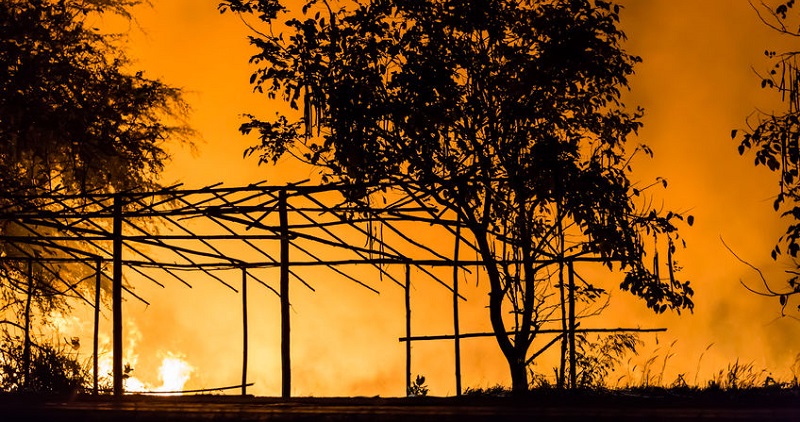Do not rush or speed to get out of the smoke. Resist the panic reflex and keep a reasonable speed. If you have trouble seeing the road, use the white stripe on the right edge of the lane as your guide.
Drivers Need Extra Caution in Fiery Summer Months
High temperatures and dry weather make fire dangers high in most areas of Colorado, but especially so in the high country, the Colorado Department of Transportation says.
In late June there were 13 tracked wildfires burning in the state, with the most severe in the southwestern region, according to Inciweb, the interagency government Internet clearinghouse tracking wildfires across the country.
Driving Tips to Save Your Life
Safety officials usually cordon off active fire zones, but sometimes allow restricted access. If you are allowed through a fire zone, remember there is no stopping. You may not park or stand on the highway shoulder outside of your vehicle.
In some cases, authorities will let traffic through a zone in groups led by a pilot car. Vehicles in these convoys are required to follow the pilot car and other cars in line. Absolutely do not stop.
If you face wildfire smoke while driving, turn on your headlights and keep them in the low-beam setting. High-beam headlights will reflect off the smoke particles, further limiting what you and other drivers can see. Be on the lookout for parked or slow-moving vehicles in your path. Firefighters and other emergency personnel may have parked on the side of the road.
Some drivers will make the mistake of stopping altogether or driving so slowly that they risk an auto accident.
In smoky conditions, increase the distance between your vehicle and the one ahead of you.
Do not rush or speed to get out of the smoke. Resist the panic reflex and keep a reasonable speed. If you have trouble seeing the road, use the white stripe on the right edge of the lane as your guide.
Be alert for “red flag” fire weather warnings. Safety officials issue the special warnings when weather conditions are right for a fire to start easily and spread rapidly.
Drivers should avoid driving or parking on dry grass, brush, or debris. Exhaust pipes and mufflers become extremely hot and can easily kindle a fire.
When you leave places that are susceptible to catch fire, such as a campsite or grassy roadside, stop a moment and look back to check for any signs of fire.
Don’t ever toss a lit cigarette out of your car or truck window. And don’t pretend you’ve never heard this before.
Making Vehicles Safe for Fire Season
Take steps to “spark-proof” your vehicle. CDOT urges auto or truck drivers pulling trailers to attach their safety chains with extra care. Loose chains have been known to drag along the pavement, cause sparks, and start fires on the roadside.
Be sure your vehicle is in good working order and that nothing, such as a dislodged muffler or metal strap, is dragging the ground. Be sure your tires are fully inflated. Exposed wheel rims can throw sparks when they come in contact with the pavement.
Your brakes, if not carefully maintained, can also throw sparks and set fires. When your brake pads wear out, the metal brake calipers can come into direct contact with the metal brake drum or disc. Pay attention to the chirping indicator and have those brakes looked at.
Keep a fire extinguisher in your car or truck and be sure you know how to use it. You don’t want to have to read the device’s instructions if your car or the brush around you ignites.
Know Before Leaving Home
In hot, dry months, you should always check out road conditions and check for emergency alerts before you leave your home or workplace. Avoid danger areas. It’s easy. Check out CDOT’s alert website, cotrip.org, which actively reports road closures and conditions for all reasons. Drivers within the state can dial 511 to get a rundown of road conditions and closures.
Residents near an active fire area should keep tabs on the websites and social media pages for whatever federal, state, or county agency is commanding firefighting operations.
What to Put in Your Car’s Emergency Kit
Nearly all sources urge motorists to keep an emergency kit handy.
We recommend that you start with a simple box to keep in the backseat. Throw in several bottles of water for drinking and rinsing your eyes. Will you have enough for passengers? Stock more than you think you’ll need. Add some durable food, such as granola bars, in case you face a long detour or have to wait in the traffic spawned by this kind of emergency. The fire extinguisher you’ve neglected getting in the past: Go buy one today at a big-box retailer or auto parts place. A spare, fully charged cell phone if you have one (keep it charged) or an alternate power source for your phone. Add some old tech: a map in case you need to find an alternate route to your destination, a flashlight with extra batteries, an empty gas can. A portable radio with fresh batteries can help you stay aware of fire advisories. If you really like to plan ahead, throw in a couple of blankets for when winter arrives.

